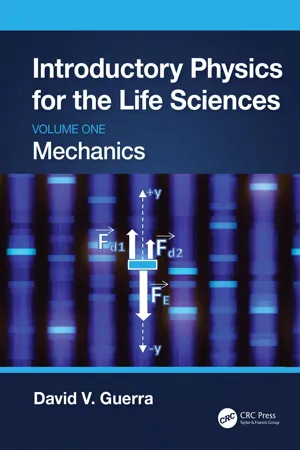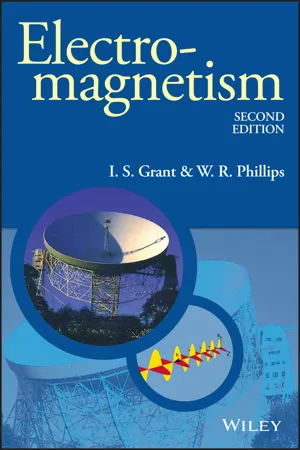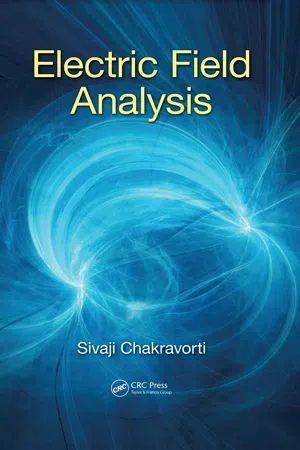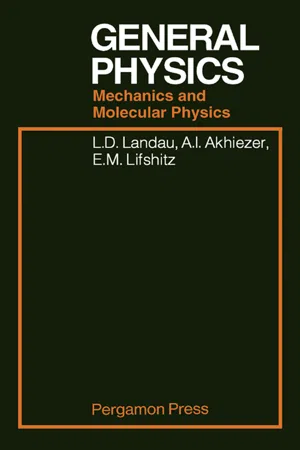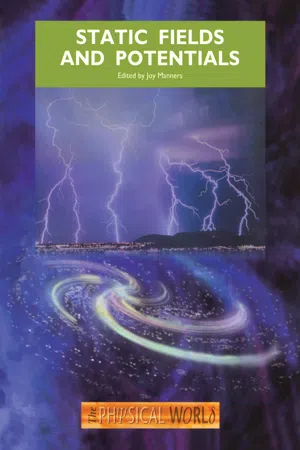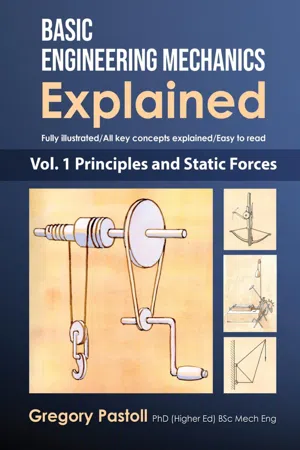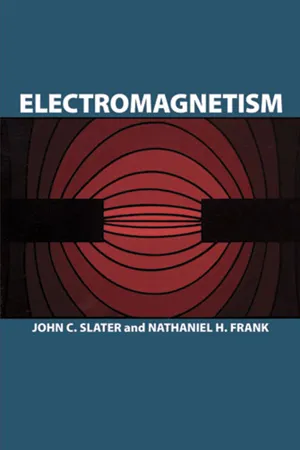Physics
Gravitational and Electric Forces
Gravitational and electric forces are fundamental interactions in nature. Gravitational force is the attractive force between objects with mass, while electric force is the attraction or repulsion between charged particles. Both forces follow an inverse square law, meaning their strength decreases with distance. Gravitational force is always attractive, while electric force can be either attractive or repulsive.
Written by Perlego with AI-assistance
Related key terms
10 Key excerpts on "Gravitational and Electric Forces"
- David V. Guerra(Author)
- 2023(Publication Date)
- CRC Press(Publisher)
An electric field characterizes how electric charge affects the region of space around it and a gravitational field characterizes how mass affects the region of space around it. A charged particle brought into a region with an electric field experiences a force, and a particle having mass brought into a region with a gravitational field experiences a force.The magnitude of the gravitational force exerted by each of the two particles, having masses m1 and m2 , respectively, on the other, when the particles are separated by a distance r, is given by Newton’s Law of Universal Gravitation as:F g=, where G = ( 6.67 ×Gm 1m 2r 210- 11Nm 2/kg 2)The gravitational field strength (magnitude of force-per-mass) at any point in the region of space around a particle having mass ms is:g =. The SI units for the gravitational field are N/kg.Gm sr 2The magnitude of the Coulomb force exerted by each of two particles, having charges q1 and q2 , respectively, on the other, when the particles are separated by a distance r is:F C=k||q 1q 2r 122The electric field strength (magnitude of force-per-charge) at any point in the region of space around a particle having charge qs is:E =. The SI units for electric field strength arekq sr 2. It is obvious that the force and field equations are similar for gravity and electrostatics. The main differences are that gravitational forces are always attractive, while electrostatic Coulomb forces can be attractive or repulsive.(N C)5.6 Gauss’ Law
In the same way that Einstein’s General Relativity gives us a geometric relationship for gravity, Gauss’ Law gives us a geometric relationship for electric fields. Gauss’ Law relates the geometry of the electric field to the arrangement of the quantities that generate the field, the charges. For example, a positive point charge, q, in Figure 5.19- eBook - ePub
- I. S. Grant, W. R. Phillips(Authors)
- 2013(Publication Date)
- Wiley(Publisher)
CHAPTER 1
Force and energy in electrostatics
The only laws of force which are known with great precision are the two laws describing the gravitational forces between different masses and the electrical forces between different charges. When two masses or two charges are stationary, then in either case the force between them is inversely proportional to the square of their separation. These inverse square laws were discovered long ago: Newton’s law of gravitation was proposed in 1665, and Coulomb’s law of electrostatics in 1785. This chapter is concerned with the application of Coulomb’s law to systems containing any number of stationary charges. Before studying this topic in detail, it is worth pausing for a moment to consider the consequences of the law in the whole of physics.In order to make full use of our knowledge of a law of force, we must have a theory of mechanics, that is to say, a theory which describes the behaviour of an object under the action of a known force. Large objects which are moving at speeds small compared to the speed of light obey very closely the laws of classical Newtonian mechanics. For example, these laws and the gravitational force law together lead to accurate predictions of planetary motion. But classical mechanics does not apply at all to observations made on particles of atomic scale or on very fast-moving objects. Their behaviour can only be understood in terms of the ideas of quantum theory and of the special theory of relativity. These two theories have changed the framework of discussion in physics, and have made possible the spectacular advances of the twentieth century.It is remarkable that while mechanics has undergone drastic amendment, Coulomb’s law has stood unchanged. Although the behaviour of atoms does not fit the framework of the old mechanics, when the Coulomb force is used with the theories of relativity and quantum mechanics, atomic interactions are explained with great precision in every instance when an accurate comparison has been made between experiment and theory. In principle, atomic physics and solid state physics, and for that matter the whole of chemistry, can be derived from Coulomb’s law. It is not feasible to derive everything in this way, but it should be borne in mind that atoms make up the world around us, and that its rich variety and complexity are governed by electrical forces. - eBook - ePub
- Sivaji Chakravorti(Author)
- 2017(Publication Date)
- CRC Press(Publisher)
G ). Consequently, the electrostatic force between two electric charges of unit magnitude is significantly higher than the gravitational force between two masses of unit magnitude.From Equation 1.3 , it is seen that the electrostatic force between two electric charges of magnitude 1 C separated by a distance of 1 m will be a colossal 9 × 109 N ! On the other hand, the gravitational force between two masses of magnitude 1 kg separated by a distance of 1 m will be a meagre 6.67 × 10–11 N ! These values clearly show the enormous difference between magnitudes of electrostatic and gravitational forces.The comparison can also be made between the electrostatic and gravitation forces between two electrons separated by a given distance. Considering the charge of an electron as e (1.60217657 × 10–19 C) and the mass of the electron as m e (9.10938291 × 10–31 kg), the ratio of electrostatic to gravitational forces between two electrons is given by=||F →e l e c t r o s t a t i c||F →g r a v i t a t i o n a l(2e)m ek G≈ 4.1 7 4 × 104 2 ( 1.4 )The above equation shows how strong electrostatic forces are compared to gravitational forces! If this reasoning is applied to the motion of particles in the universe, one may expect the universe to be governed entirely by electrostatic forces. However, this is not the case. The electrostatic force is enormously stronger than the gravitational force, but is usually hidden inside neutral atoms. On astronomical length scales, gravity is the dominant force and electrostatic forces are not relevant. The key to understanding this paradox is that electric charges could be of either positive or negative polarity, whereas the masses that cause gravitational forces are only positive, as there is nothing called negative mass . This means that gravitational forces are always cumulative, whereas electrical forces can cancel each other. For the sake of an argument, consider that the universe starts out with randomly distributed electric charges. Initially, electrostatic forces are expected to completely dominate gravity. Because of the dominant electrostatic forces, every positive charge tries to get as far away as possible from the other positive charges, and to get as close as possible to the other negative charges. After some time, the positive and negative charges come near enough (≈10–10 - eBook - ePub
General Physics
Mechanics and Molecular Physics
- L D Landau(Author)
- 2013(Publication Date)
- Pergamon(Publisher)
x from it:φ = − 2 π σ x + constant .§22. Gravitational field
As well as electrical interaction, gravitational interaction plays an extremely important part in Nature. This interaction is a property of all bodies, whether they are electrically charged or neutral, and is determined only by the masses of the bodies. The gravitational interaction between all bodies is an attraction, the force of interaction being proportional to the product of the masses of the bodies.If the bodies may be regarded as particles, the force of gravitational interaction is found to be inversely proportional to the square of the distance between them and proportional to the product of their masses. Denoting the masses of the bodies by m 1 and m 2 and the distance between them by r , we may write the gravitational force between them asF = − Gm 1m 2/r 2,where G is a universal coefficient of proportionality independent of the nature of the interacting bodies; the minus sign shows that the force F is always attractive. This formula is called Newton’s law of gravitation .The quantity G is called the gravitational constant ; it is evidently the force of attraction between two particles each of unit mass at unit distance apart. The dimensions of the gravitational constant in the CGS system areand its value is[ G ]=[ F ]/[ r ]2[ m ]2=(g .cm).sec− 2cm 2/g 2=cm 3/ g.sec 2G = 6.67 ×10− 8cm 2/ g.sec 2.The extremely small value of G - eBook - ePub
Information and the World Stage
From Philosophy to Science, the World of Forms and Communications
- Bernard Dugué(Author)
- 2017(Publication Date)
- Wiley-ISTE(Publisher)
The new interpretation taking shape at the moment splits physics into two categories: mechanics of arrangements and dynamics of information. The former dominates classical physics and the latter concretizes itself with the quantum theory of matter. Electromagnetic physics has remained ambiguous. It uses classic notions, fields and their influences (Coulomb, Maxwell), but the processes that it describes are not classic in the mechanical sense. The natural world in which we are evolving includes two kinds of forces, namely those whose essence is mechanical and those linked to electric charges. It is a strange nomological coincidence that the formula of electrostatic force is similar to that of gravitation. The first is proportional to the product of the two electric charges, q1 and q2. The second is proportional to the product of the masses, m1 and m2. The two are inversely proportional to the square of the distance. The fundamental difference is that gravitation attracts, whereas electric force attracts or repels according to whether the charges have identical or opposed signs.Mass is not reduced to a gravitational force which, incidentally, is not an actual force. We also know inertial mass. However, regardless of the nature of mass, we are dealing with a physics of forces, a type of mechanics and a science of arrangements. Cosmology studies the arrangement of masses in the universe. Rational mechanics studies several types of phenomena, such as how masses clash and transmit to one another a part of energy or impulse. Inertia designates nothing more than the resistance of a mass against any force attempting to move it. Hence, the formula that calculates the acceleration g based on the force F applied to a mass m is F = mg. Rational mechanics also studies another type of movement that differs from translation, namely rotation. Once again, in this case, the inertial mass is opposed to any force aiming to make a solid turn. In physics, mass is a property of matter that describes how material elements are arranged in space and opposed to forces (whichever their origin), and also how they generate forces such as gravitation forces.4.2. Electric charge, spin and dynamics of information
- eBook - ePub
- Chris Webster(Author)
- 2012(Publication Date)
- Routledge(Publisher)
strong nuclear force is the strongest of nature’s forces; however, like the weak force, it has a very short range and is ineffective beyond the region of the proton or the neutron. Only the heavier atomic particles are influenced by this force; both protons and neutrons are subject to its influence, whereas electrons, photons, and neutrinos are not. The strong nuclear force is the source of great energy. Perhaps the best illustration of this concept can be found in sunlight. It is the strong nuclear force that controls the nuclear reactions in fusion reactors, examples of which are our own sun and other stars.The Electromagnetic Force
By comparison to gravity, a magnetic force exerts a stronger force, though its effect is felt over a much shorter distance. If you hold even a very small magnet over a nail, you will see how the force from the magnet pulls the nail upward off the surface it sits on to snap onto the magnet. The force exerted by a magnet small enough to hold in your hand is greater than the gravitational force exerted by an object as large as the earth. Move the magnet just a couple of inches above the nail and the electromagnetic force is not strong enough to move the object, let alone lift it. It’s only when the magnet is located very close to the nail that its force exerts any perceivable influence.Electromagnetic force plays a major role in all the phenomena that we encounter in our daily lives. Electromagnetism provides the force that holds all the electrons and protons together in all matter. Without this force, matter would not bind together to form atoms, atoms could not form molecules, and the structures that form all the recognizable material could not exist. Still, as important as this force is to our very existence, its implications may be of relatively limited value to us as animators attempting to gain more insight into action and dynamics.Gravity
Unlike the other forces of nature for which range is limited, the range of gravity - eBook - ePub
- Joy Manners(Author)
- 2020(Publication Date)
- CRC Press(Publisher)
After reading Sections 3.1 and 3.2, you may be wondering why the electrostatic force is not more apparent in everyday life. Matter has two basic properties that cause it to exert forces: one of these properties is mass, which produces gravitational forces, and the other is charge, which produces electrostatic forces. Yet, although we are aware of the gravitational force as soon as we fall out of bed in the morning, we usually have to perform an experiment before we become conscious of the electrostatic force. One of the reasons for this apparent paradox arises from the fact that there are two types of charge, positive and negative, but only one type of mass. The attraction between two equally but oppositely charged objects, and the resulting charge cancellation when they coalesce, produces a single electrically neutral body that does not exert a net electrostatic force. This explains why most lumps of matter contain precisely equal amounts of positive and negative charge and are therefore electrically neutral. However, because there is only one kind of mass, which always gives rise to an attractive gravitational force, two objects coalescing will simply form a more massive body that will exert an even greater gravitational force on other masses. As you will shortly see, the gravitational force is extraordinarily weak, but this is compensated by the very large mass of bodies such as the Earth, that exert significant gravitational forces. Although electrostatic forces are not often immediately apparent in nature, they can, under certain circumstances, produce very dramatic effects. Below we describe the conditions that give rise to two hazardous manifestations of electrostatic forces: lightning storms and the occasional explosion of oil tankers during cleaning.In 1753, a scientist called Richmann was killed during a lightning experiment. His contribution to science did not end with his death, however, for his body was dissected to discover the effects of his last experiment on his vital organs. - eBook - ePub
Basic Engineering Mechanics Explained, Volume 1
Principles and Static Forces
- Gregory Pastoll, Gregory Pastoll(Authors)
- 2019(Publication Date)
- Gregory Pastoll(Publisher)
different reading, measurably less than 26 kg. To understand this, we need to understand the connection between weight and gravity.Weight, Newton’s Law of Gravitation, and gravitational accelerationIsaac Newton, following the work of Robert Hooke, confirmed that a gravitational force exists between any two objects in the universe. Simply due to the fact that the objects have mass, they attract each other. This means that if two rocks are drifting in space, near one another, they will each exert a pull on the other, the result of which is that they will gradually accelerate towards one another. The more mass the two objects possess, the greater is this force. The further apart they are, the smaller is this force. Newton’s Law of Gravitation tell us that the magnitude of the gravitational force, F, depends on these variables, in the following relationship:F = (Gm1 m2 )/r2Where G is the universal gravitation constant, m1 and m2 are the masses of the two objects, and r is the distance between their centres of gravity.This law applies to all bodies, not only to the gravitational force between a given object and the Earth. Every object that possesses mass attracts every other object with a force of attraction given by the above equation. It might be hard to believe that two pencils lying on your desk exert a gravitational pull on one another, but they do. The magnitude of this pull is insignificant, because both of their masses are vastly smaller than the mass of the earth.The magnitude of the gravitational force of attraction between two small objects was first determined in a famous experiment by the British scientist Henry Cavendish in 1797. A torsion wire suspended from an overhead beam supported a horizontal rod, on the ends of which were mounted two small lead spheres.When the rod had settled into an equilibrium position, two larger spheres were brought from a distance, to a position on the circle of movement close to the small ones, and equidistant from them. The small spheres moved towards the larger ones with a force that could be determined by the amount of twist they caused in the torsion wire. - Nima Gharib, Javad Farrokhi Derakhshandeh, Peter Radziszewski(Authors)
- 2022(Publication Date)
- Elsevier(Publisher)
Indeed, it is not hyperbolic to assert that we live in an electromagnetic world—nearly every force encountered in daily life, with the exception of gravity, is electromagnetic in origin. Because the strong forces that keep protons and neutrons together in the atomic nucleus have an incredibly narrow range, humans do not “feel” them, despite their hundredfold greater strength than electrical forces. Weak forces, which are responsible for some types of radioactive decay, are likewise short-ranged and significantly weaker than electromagnetic forces. Gravity, on the other hand, is so pitifully weak (in comparison to the others) that we only sense it in the presence of massive mass concentrations (such as the earth and the sun). The electrical attraction between two electrons is (10e 42) times greater than their gravitational attraction, and if atoms were kept together by gravity forces alone, a single hydrogen atom would be substantially bigger than the entire universe. Electromagnetic forces are not only the most common in everyday life, but also the only ones fully understood. Yes, there are classical and relativistic theories of gravity (Newton's law and Einstein's general relativity), but no quantum mechanical explanation (though many scholars are working on it). Current theories of weak interactions and strong interactions are both extremely effective (albeit complex). In classical approach, the fundamental parameters are known as mass (M), length (L), and time (T), which more or less are observable by our sense. In certain ways, we can detect them without the need of supplementary experimental instruments. In electrodynamics, a fourth fundamental quantity is the “charge,” which requires the use of specialized auxiliary measures. As a result, they are undetectable to the amateur and theoretically rather challenging- eBook - ePub
- John C. Slater, Nathaniel H. Frank(Authors)
- 2012(Publication Date)
- Dover Publications(Publisher)
The study of forces, on the other hand, is difficult and complex. The first forces brought into mathematical formulation were gravitational forces, as seen in planetary motion. Next were elastic forces. Then followed electric and magnetic forces, which are the subject of this volume. Their study was mostly a product of the nineteenth century. During the present century, it has become clear that electromagnetic forces are of far wider application than was first supposed. It has become evident that, instead of being active only in electrostatic and magnetostatic experiments, and in electromagnetic applications such as the telegraph, dynamo, and radio, the forces between the nuclei and electrons of single atoms, the chemical forces between atoms and molecules, the forces of cohesion and elasticity holding solids together, are all of an electric nature. We might be tempted to generalize and suppose that all forces are electromagnetic, but this appears to be carrying things too far. The prevailing evidence at present indicates that the intranuclear forces, holding together the various fundamental particles of which the nucleus is composed, are not of electromagnetic origin. These forces, of enormous magnitude, and appearing in the phenomena of radioactivity and of nuclear fission, appear subject to laws somewhat analogous to the electromagnetic laws, but fundamentally different. In spite of this, the range of phenomena governed by electromagnetic theory is very wide, and it carries us rather far into the structure of matter, of electrons and nuclei and atoms and molecules, if we wish to understand it completely. The equations underlying the theory, Maxwell’s equations, are relatively simple, but not nearly so simple as Newton’s laws of motion. Instead of stating the whole fundamental formulation of the subject in the first chapter, as one can when dealing with mechanics, about half of the present book is taken up with a complete formulation of Maxwell’s equations. We start with simple types of force, electrostatic and magnetostatic, and gradually work up to problems of electromagnetic induction and related subjects, all of which are formulated in Maxwell’s equations.In the development of electromagnetic theory, there has been a continual and significant trend, which in a way has set the pattern for the development of all of theoretical physics. This has been the trend away from the concept known as “action at a distance” toward the concept of field theory. The classical example of action at a distance is gravitation, in which simple nonrelativistic theory states that any two particles in the universe exert a gravitational force on each other, acting along the line joining them, proportional to the product of their masses, and inversely proportional to the square of the distance between them. Such a force, depending only on the positions of the particles, quite independent of any intervening objects, is simple to think about, and formed the basis of most of physical thought from the time of Newton, in the latter half of the seventeenth century, on well into the nineteenth century. The first electric and magnetic laws to be discovered fitted in well with the pattern. First among these was Coulomb’s law. Coulomb investigated the forces between electrically charged objects, and found that the force between two such objects was in the line joining them, proportional to the product of their charges (which could be defined by an experiment based on this observation), and inversely proportional to the square of the distance between them, in striking analogy to the law of gravitation. Magnets similarly fell in with the scheme. A theory of the forces between permanent magnets can be built up by considering that they contain magnetic north and south poles, and that the force between two poles is proportional to the product of the pole strengths, and inversely proportional to the square of the distance. It is true that single poles do not seem to exist in nature, but an ordinary magnet can be considered as made up of equal north and south poles in juxtaposition, a combination known as a “dipole.”
Index pages curate the most relevant extracts from our library of academic textbooks. They’ve been created using an in-house natural language model (NLM), each adding context and meaning to key research topics.
